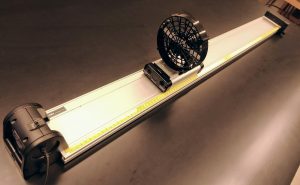Constant Acceleration
In this experiment, you will use a sensor to track the motion of a freely-rolling cart on a flat track as it is accelerated by a fan. You will test two situations: one in which the cart starts from rest, and the second in which the cart is given an initial push in the opposite direction as the fan, so that it changes direction and comes back to its initial location.
Tasks/Objectives
- Predict the shape of the position, velocity, and acceleration vs. time graphs for the cart in both cases above.
- Extract acceleration from position, velocity, and acceleration vs. time graphs
- Compare accelerations found from different graphs
Resources
- Cart with fan attachment
- Flat track
- Ruler
- Motion sensor
- Science Workshop interface and DataStudio software
- Datastudio setup file: const_accel (right-click and choose “Save Link As”)
- HOW TO – Use Sensors with ScienceWorkshop Interfaces
- HOW TO – Analyze Data with DataStudio
Background
In kinematics, we describe how an object moves using the physical quantities position (x), velocity (v), and acceleration (a). These three quantities are connected in the following way: \begin{matrix} \bar{v}=\frac{\Delta x}{\Delta t} & \bar{a}=\frac{\Delta v}{\Delta t} \end{matrix}
One-dimensional motion with constant acceleration is a useful model for many physical situations, such as an object falling in Earth’s gravity or an accelerating car. If the acceleration is assumed constant, as opposed to changing in time, it can be shown graphically or using calculus that the following relationships hold:\begin{matrix} a=v_0 + at &x=x_0+v_0t+\tfrac{1}{2}at^2 \end{matrix}
Using any model means understanding understanding its limitations and how to apply it correctly. In many real situations acceleration is not constant. The falling object’s acceleration changes abruptly when it hits the ground, and automobiles accelerate differently at high speeds compared to low speeds.